Digital news and social media continue to grow, with mobile devices rapidly becoming one of the most common ways for Americans to get news. As journalists and media practitioners gather for the annual Online News Association conference, here are 10 key findings from recent Pew Research Center reports about today’s digital news media landscape:
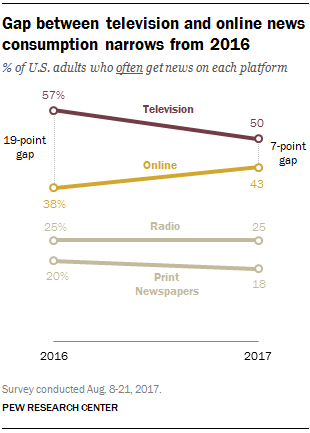
The gap between television and online news consumption is narrowing. As of August 2017, 43% of Americans report often getting news online, a share just 7 percentage points lower than the 50% who often get news on television. The gap between the two news platforms was 19 points in early 2016, more than twice as large. The share of Americans who often get news from TV – whether from local TV news, nightly network TV news or cable news – has fallen, while the portion of Americans often getting news online – either from news websites/apps or social media – has grown.
Use of mobile devices for news continues to grow. As of spring 2017, 45% of U.S. adults often get news on a mobile device, up from 36% in 2016 and 21% in 2013. The use of desktop or laptop computers for news remains steady, with 31% saying they often get news this way. In all, 85% of Americans ever get news on a mobile device, the same proportion who do so on a desktop computer. And, among those who get news both ways, mobile devices are increasingly preferred. Nearly two-thirds (65%) of U.S. adults who get news on both mobile and desktop prefer mobile, up from 56% in 2016.
Older adults are driving the growth in mobile news use. More than eight-in-ten U.S. adults (85%) now get news on a mobile device, up from 72% in 2016. The recent surge has mainly come from growth among older Americans. Roughly two-thirds (67%) of those ages 65 and older now get news on a mobile device, a 24-percentage-point jump from 2016 and about three times the share in 2013. Mobile news use also grew among those ages 50 to 64, with about eight-in-ten (79%) now getting news on mobile, about double the share from 2013. Large increases in mobile news use also occurred among those in lower-income households.
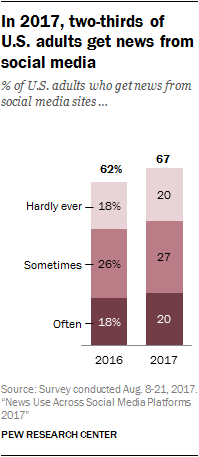
Two-thirds of Americans (67%) get at least some news on social media. This represents a modest increase from 62% in 2016, but similar to mobile, this growth was driven by substantial increases among older Americans. For the first time in Pew Research Center surveys, more than half (55%) of Americans ages 50 and older report getting news on social media sites, a 10-percentage-point jump from 2016. Three of the social media sites measured – Twitter, YouTube and Snapchat – grew their shares of users who get news on their site. Twitter saw the largest growth in 2017 (up 15 percentage points) and had the largest share of users to report getting news there (74%).
Nonwhites and the less educated increasingly say they get news on social media. About three-quarters of nonwhites (74%) get news on social media sites, up from 64% in 2016. This means that nonwhites (including all racial and ethnic groups, except non-Hispanic white) are now more likely than whites (64%) to get news on social media. Social media news use also increased to 69% in 2017 among those with less than a bachelor’s degree, surpassing those with a college degree or higher (63%).
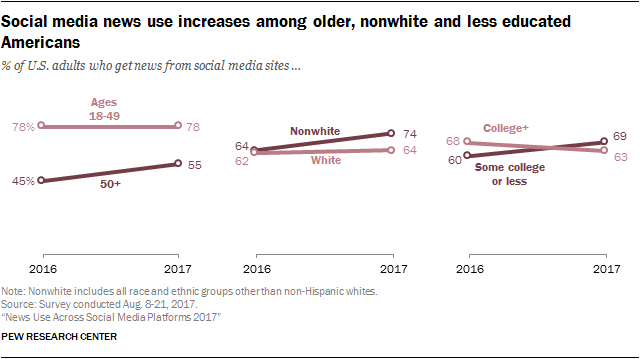

Many Americans believe fabricated news is sowing confusion, and about a third (32%) say they often see made-up political news online. Nearly two-thirds of U.S. adults (64%) say fabricated news stories cause a great deal of confusion about the basic facts of current issues and events. About a third of U.S. adults (32%) say they often see made-up political news online, while 39% sometimes see such stories and 26% hardly ever or never do. About half (51%) say they often see political news online that is at least somewhat inaccurate – a higher proportion than those who say they see news that is almost completely made up (32%). About a quarter (23%) say they have ever shared made-up news stories themselves, with roughly equal shares saying they have done so either knowingly or unknowingly. A large majority (84%) of Americans say they are at least somewhat confident in their ability to recognize fabricated news.
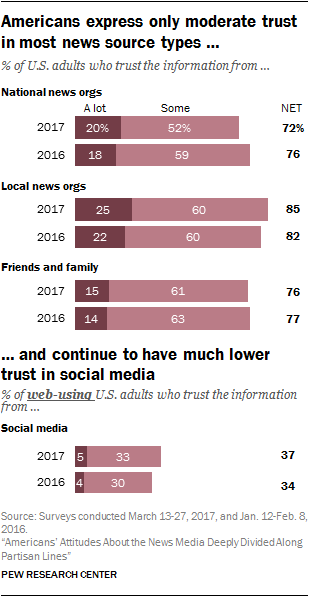
Americans have low trust in information from social media. Just 5% of web-using U.S. adults have a lot of trust in the information they get from social media, nearly identical to the 4% who said so in 2016. This level of trust is much lower than trust in national and local news organizations, and in information coming from friends and family. In fact, in a separate study focusing on science news about twice as many social media users distrust science posts on social media as trust them (52% compared with 26%, 21% of social media users do not see any science posts).
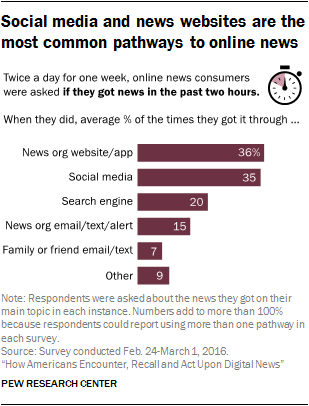
Social media and direct visits to news organizations’ websites are the most common pathways to online news. When asked how they arrived at news content in their most recent web interaction, online news consumers were about equally likely to say they got news by going directly to a news website (36% of the times they got news, on average) as they were to say they got it through social media (35%). They were less likely to access news through emails, text messages or search engines.
While social media is a common pathway to news, when people follow news links, source recognition is lower for news accessed through these platforms than it is when the link comes from a news organization. When news links came directly from a news organization’s emails, texts or alerts, the individual could name a source for that link 78% of the time. That far outpaced source recall when a link came through social media (52% of such instances) or a friend’s email or text (50%).
Online news that comes via emails and texts from friends or family is the type of news encounter most likely to result in a follow-up action. Among the five pathways studied, news instances spurred by emails and texts from friends or family elicited the most activity; nearly three-quarters (73%) of these instances were acted upon in some way. That outpaced social media and direct visits to a news organization’s website, where a follow-up action occurred in about half of news instances (53% and 47%, respectively). Overall, talking with someone offline, whether in person or over the phone, was the most common action taken with digital news.
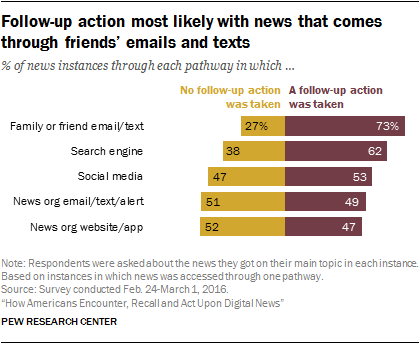
An analysis of nearly 2,700 different search terms associated with the water crisis in Flint, Michigan, shows that online searches can be a good proxy for the public’s interests, concerns or intentions. The data revealed that residents of Flint were searching for information about their water before the government recognized the contamination and before local and regional news media coverage intensified beyond a handful of stories related to the initial switch of the water supply. While news was the first type of information people searched for, questions about personal and public health implications soon came to the forefront. The politics of the water crisis – which involved the governor of Michigan, the city of Flint and several agencies – did not resonate as a local search topic until President Barack Obama reacted, when the story spread nationally.


